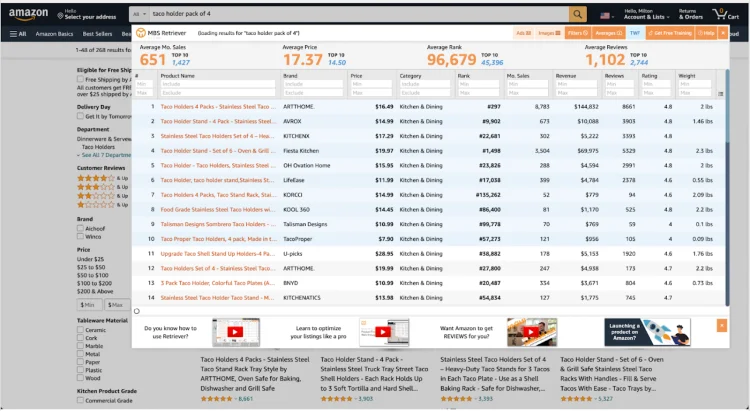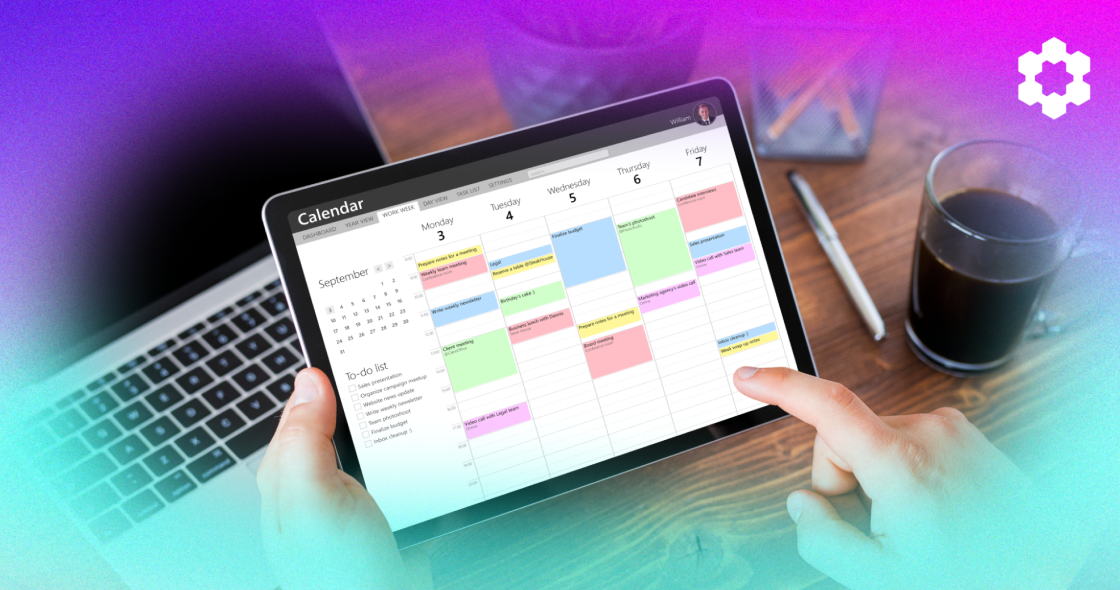With so many metrics available – many of which may not be relevant to your business – it’s difficult to know which ones will truly help you achieve Amazon ecommerce success. That’s why knowing how all the sections of your business work, what influences them, and how to fix any problems is critical to your growth and sustainability.
How do you generate an accurate exterior look at your business? How do you get a concise picture of how things are going? If your sales are dipping or remain stagnant, what are the correct actions to take to get them trending upwards?
Analyze Potential Customers with Sessions Metrics
Sessions directly measure how many individual people have viewed your listing within a 24 hour period. They are important because each session is a potential customer; and of course, any time you can get someone to view your product, it’s a potential sale.
So how do you increase sessions? There are a couple of strategies:
- Organic: Organic sessions are technically free, but you have to spend a good amount of time finding and targeting keywords – the search terms customers use to find your product. You can also court more sessions with detailed titles, bulleted lists (using those high-volume keywords), and manicured descriptions to your products that, once again, incorporate relevant keywords. You’ve probably noticed a theme here. It also helps to have professional product photography and product demo videos; the better something looks, the more people will want to engage with it, and the more sessions you’ll get.
- Paid: Paid sessions come from advertising, either on or off-Amazon. To help seal the deal with a paid session strategy, make sure you get (and keep) the “buy now” feature. That is, make sure you have the Buy Box, otherwise someone else gets the sale when a customer clicks the Buy Now button.
The related metrics that influence Sessions are:
- Ad Impressions: How many times your ad is shown to potential customers
- Ad Clicks: Potential customers clicking on your ad.
- BuyBox %: Ensuring you get the sale when someone goes to buy the product.
- Star Ratings: The amount of stars you have, relating to your reviews.
- Sales Rank: The higher you rank, the more organic visibility you have, and thus more potential people clicking on your products.
Knowing how these metrics relate to Sessions will help you figure out the problem if your Sessions are going down.
Look at Conversions, Not Clicks
Conversions measure the average number of units sold per session. So, for example, if you have a 30% conversion rate, you’re selling 3 units for every 10 sessions. Conversions are directly influenced by the following factors:
- Images + video: As mentioned previously with sessions, having clean, crisp visual elements on your listing may give your product(s) more appeal, and entire prospective customers to become active buyers.
- Optimized Text: Make sure your title, bullets and product descriptions are Grade-A content.
- Star Ratings: This quick way for customers to see how your business rates is worth its weight in gold.
- Reviews: Try to leverage the quality of your 10 most recent reviews.
- Price: Do some research, and make sure your price is competitive to maximize your sales and profits.
Related metrics that influence conversions include:
- Advertising Clicks: How many people did you drive to your listings, and how much did it cost? Was it worth it?
- Quantity Ordered / Quantity Paid For: These are informational, “after-the-fact” metrics, but help give you the broader overview of how well you stocked.
- Buy Box %: The Buy Box is a term used by Amazon to indicate that you will “win” the sale if someone clicks “Buy Now.” If an Amazon customer uses Alexa to verbally order something, it will automatically purchase from whoever has the “Buy Box.” As there can be many sellers of one product on Amazon, if you have the Buy Box, you will win the sale when a customer decides to add it to their cart. So, if you lose the Buy Box, you’re not getting the conversion, as some other seller has the Buy Box and is getting the sale! That’s why you need to watch your Buy Box percentage to make sure you are getting each sale.
If you understand how each of these factors relates to your product, you can identify which areas of your business need attention to get better conversions.
Profit Metrics: Measuring What You’re Really Making
Many Amazon Sellers are focused on how high their revenue is, but that can create a false narrative of success. Knowing your actual profit can be difficult, too, because there are many elements that determine it, which is usually why sellers just look at Revenue.
Profit is what is left after deducting all of the following:
- Landed Cost of Goods Sold (COGS): What it costs you to get it from your manufacturer.
- Advertising Costs: The money spent advertising on Amazon.
- Sales Tax/VAT: Any Tax/VAT fees.
- Amazon Service Fees. A percentage of each sale that Amazon charges you.
- Amazon Shipping Fees. Shipping to Amazon FBA warehouses, or using Amazon’s shipping services for FBM Orders.
- Promotional Rebates: Discounts you create that are redeemed in purchases.
- Refunds. Customers claim, which have to be taken out of your later payouts.
- FBM Sales Fees: Amazon charges you a percentage of each sale.
- FBA Shipping Fees: Shipping costs for each sale from Amazon warehouses.
- FBA Inventory Storage: Storage fees Amazon charges for your stock in their warehouses.
- FBA Returns & Removals: Amazon charges you for returns and removals they handle.
- Amazon Account Fee: Your monthly subscription as an Amazon Seller.
- Coupon Redemptions: Coupons being redeemed, which come out of your sales revenue.
Of course, this does not take into account external fees you could have, like Google or FB Ads, VA payroll, or subscriptions to other softwares.
And look, that is a lot. You’re going to need to track all of this for each product you sell, so you can understand which products are actually selling well and making profit.
The related metrics that influence profit are:
- Gross Profit: Deducting everything above from your Amazon Sales Revenue will give a Gross Profit.
- Average CPC: The average cost you pay for someone clicking on your ads.
- Ad Costs: How much you spend on advertising.
- Costs of Goods Sold: Our total costs of goods sold. Graphed, this helps you see how cost relates to your revenue and profits.
- Product Sales Revenue: Your revenue from all sales, so you can see how it relates to your profit.
- Net Revenue: “Corrected” Product Revenue, after removing discounts. If you have many discount sales, the Net Product Revenue stat is a much better and more accurate stat for seeing real revenue.
- Amazon Payouts: How much you’re being paid out from Amazon every two weeks.
- Gross Profit After Sales Tax & Ads: This is a great stat to look at, as it already calculates your profit after removing Sales Tax and Amazon Advertising Costs.
Now, many of these metrics you can’t even get on Amazon. You need a tool that can provide the most important Amazon metrics. If your profit is going down, check these stats to find date-coincident points to see what may be the cause.

5-Star Ratings & Reviews on Amazon
As mentioned previously, reviews are among the best metrics for sellers on Amazon, so keeping a steady flow of new reviews is important. They can genuinely make or break your product and company sales. Buyers almost always look at product ratings before making a purchase, so keeping and maintaining a high star rating is critical to your success. But how can Amazon sellers tap the powers of reviews?
First, make sure your product is high-quality, and use that to build an engaging brand experience for customers. This can really help one-time shoppers become repeat buyers. Make sure you follow up, and build a connection with your customer base with regular communication, and let them know how they can most easily reach you. Once you’ve established that connection, feel free to be direct, and encourage new and repeat customers to write Amazon reviews for your product.
While you’re at it, check out these related metrics, which will influence your star rating:
- Average Customer Reviews
- Number of Customer Reviews
- Average Number of Stars
- Number of New Customers
Having a high star rating is great, but if you’re not getting new reviews, it will harm you in the long run. If you have a ton of reviews, but not a high star rating, you’re not going to get many new sales. If you’re not getting new customers, you’re not going to be getting in a steady flow of new reviews. SO, as with all things, balance is key. Make sure you can adapt and find yours.
The 4 Metrics Needed to Simplify the Amazon Lifecycle
You might be asking yourself right now, “How can there only be four metrics that cover every aspect of selling on Amazon? Why only four KPIs?” The answer is in the Amazon Sales lifecycle:
- Search: A potential customer sees your product on Amazon (Sessions).
- Add to Cart: If they like it, they purchase it (Conversion).
- Purchase: Once purchased, you get a piece of the sale (Profit).
- Review: If they like the product (or not) they can leave a review (Review) .
There are many other Amazon metrics, but what’s important to note is that ALL of them directly impact one of these four KPIs. There can be many “KPIs” for different parts of your Amazon business, but the four metrics laid out here are what you need for your entire Amazon account, as well as the overriding KPIs for each Product you sell.
So, the next time your sales go down, don’t automatically scale back, or examine PPC or your listings. And definitely don’t decide not to act! Instead, ask yourself which KPI is actually down, then drill into the areas that relate to that KPI. Then you’ll know you can take the right actions to get your sales going back up!
If you’re looking for an all-in-one tool that can help you on your journey as a seller in the Amazon lifecycle, Carbon6 can help! Check out ManageByStats today, and learn how to easily manage and scale your Amazon business!








